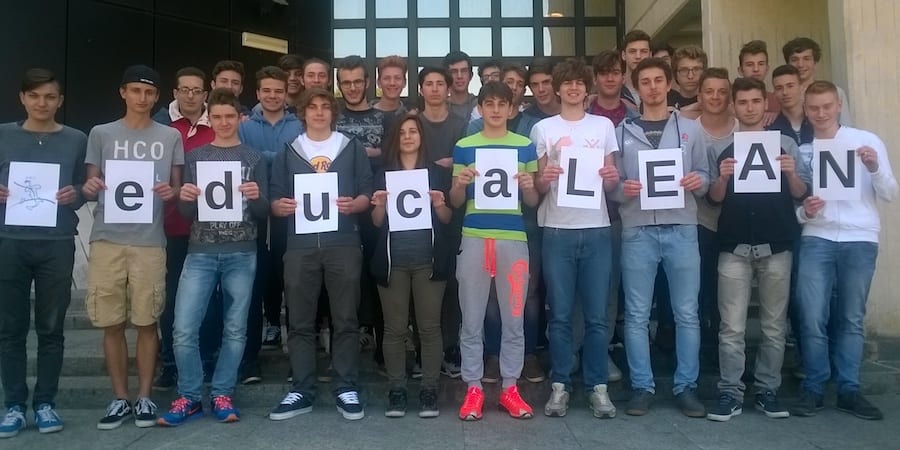
Better learning in Italian high schools using lean and Scrum
FEATURE – Is the traditional teaching model used in our schools obsolete? A high school in Italy has been experimenting with lean thinking and Scrum applied to students’ learning, and the results have been enlightening.
Words: Giuseppe Acquasaliente, lean coach, Istituto Lean Management - Italy
Education systems around the world are under mounting pressure to provide students with the knowledge and skills they will really need to become productive members of society and tap into their full potential. Traditional approaches to teaching – based on lessons delivered in classrooms, homework and regular tests – are increasingly considered obsolete, in that they don’t develop fundamental capabilities like teamwork.
The need to reform education is so pressing that even international institutions like the European Union are weighing in. With its Lisbon Protocol, the EU has identified a set of key competences that should be developed over the course of a person’s studies and that are considered as essential for the future: learning to learn; planning; communication; collaboration and participation; acting autonomously and responsibly; problem solving; identifying correlations and links; and gathering and interpreting information.
There is more. The global challenges we face (such as climate change and mass migration) and the nearly unlimited access to information through the Web (with the heightened sense of responsibility and need for critical thinking it calls for) mean that our education systems need to shift their focus from knowledge to competencies.
We at Istituto Lean Management in Italy saw an opportunity, after discussing this topic with a number of high school teachers and looking into it in more depth. In particular, we noticed how many of the skills listed by the European Union in its document correspond to the sort of capabilities that lean thinking develops in people over the course of a transformation (largely based on the creation of value, on-the-job learning, and a structured relationship between teacher and learner).
So we asked ourselves: could lean somehow be applied to teaching in high schools (with students between 14 and 18 years of age)?
This is how our “educaLEAN” project was born, with the objective of experimenting to find out whether or not lean thinking could contribute to the improvement and modernization of education. Our experiments would focus on lean principles like teamwork, visual management, and autonomy in problem solving, coupled with traditional lean tools, such as kanban, work levelling (heijunka), and PDCA.
Once the subject of study was defined by the teacher, we wanted students to be able to carry out the related analysis in an autonomous way (independence in problem solving), in small groups (teamwork), with help from the teacher when needed (pull learning) and managing everything in a visual and levelled way. To do this, it was decided to structure the operational part of the project using the Scrum methodology.
ANALYZING THE CURRENT STATE
As we looked into the current state and the problems we’d have to tackle during the project, we were able to identify a number of critical aspects we would have to keep in mind:
- Would teachers be open to questioning the classical teaching paradigm? How will they find their new role? What subjects will they pick to experiment with this new approach?
- Would students struggle to accept this different teaching method as a legitimate way to deliver a lesson? How could we ensure they wouldn’t only study what they liked? How to ensure they wouldn’t merely copy and paste rather than deeply analyze the topic?
- How could we strike the right balance between autonomy in learning and ensuring students follow a path? How could we ensure a common level of learning?
- How could we evaluate the level of knowledge and skills the students reach? And could we make sure the best-performing students wouldn’t leave those struggling behind?
Reflecting on these challenges, we were then able to structure our project based on a set of countermeasures we wanted to test to see if we could get past the hurdles we had identified. EducaLEAN, therefore, is made of three main elements:
- LEARN – We provide on-the-job training on lean principles to the teachers involved in the project. Afterwards, a group of students is taught the Scrum method by means of a simulation game.
- APPLY – This is the core of the process we devised, based on Scrum: teachers are tasked with defining the subject to study and the suitable learning paths, the duration of the sprints (“studying units” normally taking 12/16 hours over three or four weeks), and a set of questions that will lead to in-depth analysis of the subject. Students, divided in groups, are asked to define the tasks to be completed inserting them in a backlog, estimate the difficulty of the tasks using a Poker Game with the Fibonacci sequence, assign tasks (like homework) to team members and define the state of the analysis of the subject visually by means of a scrum board and a burndown chart. They also need to ensure the sharing of completed tasks (alignment, to ensure everyone passes the final test), in particular of the skills and knowledge acquired by the members of the group. The process typically ends with a contest or event during which each group answers the questions assigned by the teacher and presents their work to others. (In the case of the group looking into robotics, the questions included: the development of robotics in the past century and current state; industrial robotics in Italy and two foreign countries; social impact of automation; five English words about robotics one must know; three risks and three opportunities resulting from robotics.) The material developed is then built into a workbook that will integrate the textbooks students normally use, thus becoming an asset for the whole classroom.
- REFLECT – Reflection on the progress achieved takes place: during the APPLY phase through retrospectives run by each group’s scrum master, with the teachers attending the meetings; and at the end of the APPLY phase, carried out by teachers to analyse the level of skills and knowledge achieved by individual students and identify any corrective action deemed necessary before the next subject is tackled.

AN EXPERIMENT
After finalizing the educaLEAN method, we carried out our first experiment. This took place in May 2016 at the Istituto Tecnico Industrial A. Rossi (a technical high school) in Vicenza. Ten classes were involved, for a total of around 220 students and ten teachers. Istituto Lean Management provided assistance throughout the project.
The subjects assigned to the various classes didn’t come from their curriculums, but were certainly relevant to the type of studies students were carrying out. They included robotics, Manufacturing 4.0, the sharing economy and innovative materials. The students worked on these topics for a whole week following the steps of the APPLY phase and respecting the typical cadence of the Scrum method (an “accelerated” simulation of three four-hour Sprints).
Upon reviewing the experiment, Unioncamere Veneto (the union of the Veneto region’s Chambers of Commerce) decided to adopt the method for a project, sponsored by the regional School Board, that was carried out in the school year 2016-2017. Called “educaRSI” – a play with words referring to the Italian verb educarsi (to educate oneself) and to RSI, which stands for Corporate Social Responsibility – the project required participating classes to dive into topic of corporate social responsibility in five different aspects: a company’s relationship with the environment, with workers, with society, with consumers, and with the whole world. Nine high schools were involved (25 classes, 400 students and 40 teachers). Over the course of the project, students also had the opportunity to ask questions to business leaders.
The EducaRSI initiative ended with a regional contest, during which each school were asked to deliver a 12-minute TED-style presentation on what had been developed by the groups of students during the experience, which was then judged by a panel formed by representatives of the Regional Government, Unioncamere Veneto, Istituto Lean Management, and the companies taking part in the project.
Both experiments were successful, in that they involved both students and teachers, allowing them to acquire specific skills related to teamwork and visual planning. The results of the investigation conducted by the teams were very interesting, highlighting good research skills, analysis and reprocessing of content.
The experiments taught us a couple of important lessons. First of all, teachers were positively surprised by the effort students put into the project, and by their ability to dive deep into a subject thanks to the teamwork-based approach typical of Scrum and to the support of ILM. Secondly, students were happy to participate in both the planning and the learning phases. They showed a great ability to deepen their understanding of a subject (also using the Web) and an effort to ensure nobody would be left behind in their understanding of the topic.
NEXT STEPS
A number of questions remain open, especially with regards to the application of this Scrum method to every-day teaching (especially for scientific subjects, as both students and teachers commented). Going forward, we aim to formalize the methodology in that sense and run more in-class experiments.
This will allow us to tackle a number of aspects of the use of Scrum in schools that, at the moment, are still unclear, such as the role of teachers, the students’ approach to evaluation, and how to manage the relationship with the parents, in particular to make them understand how we are trying to develop skills and not just technical knowledge.
Istituto Lean Management is already working with a group of teachers from two high schools (ITIS “A. Rossi” in Vicenza and ITIS “G. Marconi” in Verona) to try and use the method during classes. The first results are very positive: students show a great degree of involvement and the level of knowledge and skills developed through this method appears to be higher than what can be achieved through a traditional approach to learning.
For more information on the educaLEAN initiative, contact Giuseppe at acquasaliente@istitutolean.it
THE AUTHOR

Read more


INTERVIEW – Toyota’s approach to developing capabilities and its focus on life-long learning are inspirational. But how do people at Toyota actually learn?


FEATURE – Drawing from his direct experience at the gemba, the author shares what he learned about applying lean thinking to his family’s construction company, and a few useful tips.


FEATURE – Using an effective example from every-day life, the author discusses why Kanban is the gateway to Lean Thinking – and not just a tool.


INTERVIEW - In this interview, Lynne Smith discusses the potential and difficulties of applying Lean Thinking to NGOs and looks back at the lean transformation at the Gates Foundation.

